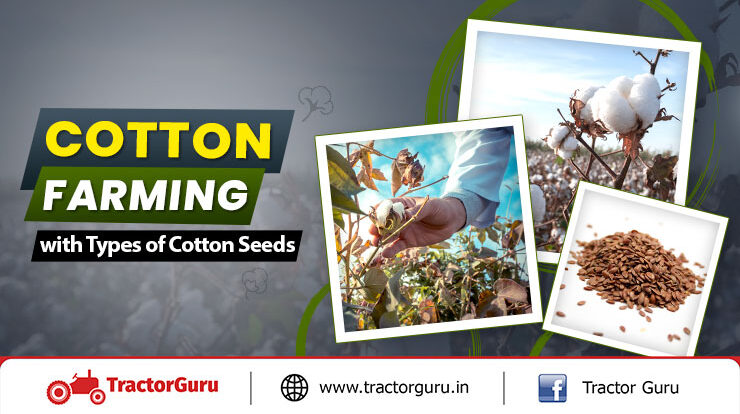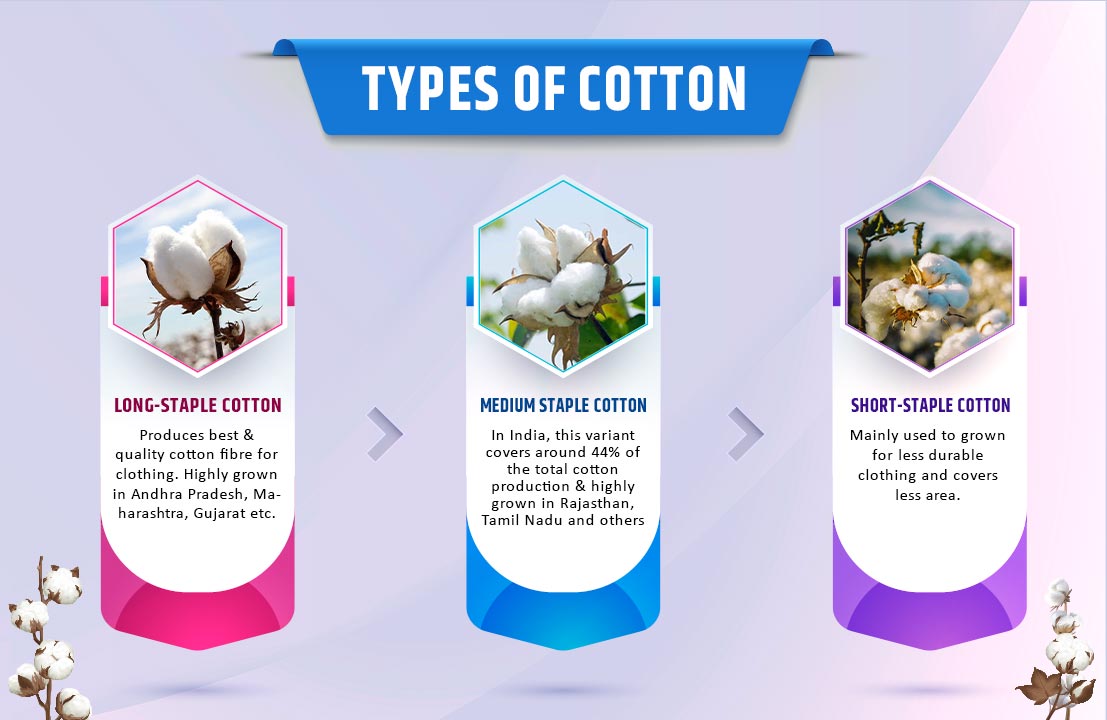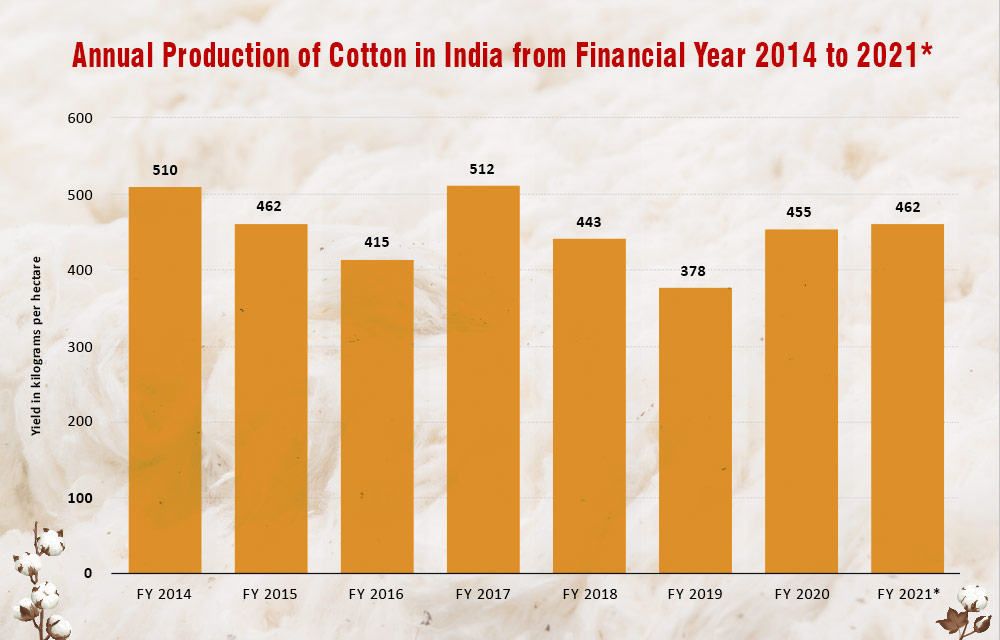Cotton Farming : A Step-wise Approach to Details And Economy

Cotton is one of the few cash crops grown around the world, which has a high demand across the world. India is an agri-based country, so cotton and cotton farming has a special place in its economy. A report in Statista shows, “In the year 2019-20, the global cotton production amounted to a lump-sum of 122 million bales”.
As per reports, around 5 million farmers in India are employed in bringing cotton clothes to your wardrobes. Also, around 45 million people are employed in selling cotton around the country and around the globe.
Cotton Farming : Types of Cotton Seed
Cotton farming starts with cotton seed plantation, crop cultivation and harvesting. However, seeds decide the quality of the crop being cultivated. Better is the variety of seeds, better is the crop, and better is the harvest also. They are 60% cotyledon, 32% coat, and 8% embryonic root and shoot.
As per the type of irrigation, the cotton seeds are divided into four types:
1. Gossypium Arboreum
Seeds in this species are fuzzy, smaller, and also rarely naked. One flower produces around 6-17 seeds or locule. These also require 15-98% of irrigation water to grow and develop.
2. Gossypium Herbaceum
Seeds in this category are sized medium to small and have a fuzzy look. Its flower produces 11 locules/seeds. These also require 15-32% of irrigation water to grow and develop.
3. Gossypium Barbadense
Flowers of these species produce 5-8 seeds/locule. These require around 32% of irrigation water. There is tufty fuzz on the seeds. Seeds are often without a coat. Fibres of this species are very long and seed-free.
4. Gossypium Hirsutum
Seeds of this category are moderately large and are fuzzy to rarely naked. The flowers in this species produce a range of 5-11 seeds/locules. These require irrigation water of 15-98%.
What are the Types of Cotton? A Brief Tour

Cotton is divided into three categories depending on the length of cotton and its quality. The soil, atmosphere and various other features are responsible for the quality and length of cotton. Let us discuss them in detail:
1. Long-Staple Cotton
Its size varies between 24-27 mm. The best cotton fibre is long, shiny and made for quality clothing. Half of the cotton country produces long-staple cotton. Highly grown in areas of high rainfall areas and in parts of Andhra Pradesh, Maharashtra, Gujarat, Tamil Nadu, Punjab, and Haryana.
2. Medium Staple Cotton
Here, the length of the fibre varies between 20-24 mm. The country produces 44% of this variant of cotton. Some of the main producers of this variant of cotton are- Rajasthan, Uttar Pradesh, Tamil Nadu, Karnataka, and Maharashtra. The clothing made from this variant sells at a lesser price.
3. short-staple Cotton
The short-staple cotton is shorter than 20 mm. It produces inferior and less durable clothing. This constitutes the remaining percentage of cotton produced in the country.
Therefore, the best type of cotton is long-staple cotton. And, hence its demand is also comparatively high.
What Soil and Climate Suit it Better?
There can be a variety of soil that suits cotton. However, there is a particular range of soil that suits the plant’s needs. The major soil types that are suitable for the plant are alluvial, clayey, and deep sandy loam. A hot and humid climate (tropical and sub-tropical type) is best for the plant and its growth.
The minimum temperature needed is 15 degrees Celcius for its germination in field conditions. However, the plant requires a temperature of 21-27 degrees celsius. It can bear a temperature of up to 43 degrees Celsius, but below 21 degrees is deteriorating for the crop.
Methods of Cultivation of Cotton in India
As far as cotton cultivation in India is concerned, the country is divided into 3 zones where cotton agriculture is popular and highly grown according to the cotton variants, as mentioned below:
1. North Zone
It consists of Punjab, Haryana, and Rajasthan.
2. Central Zone
It consists of Maharashtra, Madhya Pradesh and Gujarat.
3. South Zone
The South zone comprises Tamil Nadu, Andhra Pradesh, Telangana, and Karnataka.
Some of the major factors that affect cotton production are as follows:
- Around 65% of the total area of cotton is rainfed. Hence, you cannot cultivate in areas of low rainfall or drought-affected areas.
- The cotton crop is very prone to pests and diseases. Therefore, it requires heavy usage of pesticides.
- The market infrastructure is very much distributed and lacks adequacy in an organized form. However, the market is fruitful in many terms.
The Cropping Season, Soil Preparation and Irrigation Scheduling
Cotton and its cropping season vary slightly across the state in India. Cotton belongs to the Kharif season of farming. In these areas, you should sow the crop in March-May, and rainfed in June-July with the commencement of the monsoon. Thus, cotton is harvested at the end of the Kharif season.
While preparing the soil, you should allow deep ploughing that helps to the destruction of weeds deep-rooted in the soil. You should also prepare the field through double harrowing to ensure the proper colonization of cotton crops.
While most of the Kharif crops are rainfed, cotton farming requires a ‘complete care’ module to present a successfully fruitful economy. Cotton needs 700-1200 mm of water (in terms of rainfall or irrigation).
Economics of Cotton Cultivation in India

Cotton is an important crop and commodity produced in the Indian subcontinent. Statista says, “cotton was one of the most economically beneficial crops and was produced around 462 Kilograms per hectare”.
India is a world-leading producer of cotton and positions only behind China. Cotton cultivation in India witnessed a huge technological advancement due to the introduction of hybrid seeds in the arena in the late 1960s. Cotton farming has only seen a rise in cultivation since then. In 2018, 13 million hectares of land were cultivated growing cotton.
Cotton cultivation produces huge export traction for the Indian economy. In fact, cotton and cotton products produced around INR 783 billion in the fiscal year 2019. As cotton cultivation grows in the country, it has gained attention from the Government in terms of schemes and supporting programs.
How to begin Sustainable Cotton Farming without Harming the Natural Environment?
Cotton is a ‘water-loving’ plant. It loves water and good soil. However, the soil it grows upon may vary from region to region. Ranging from the Ganges terrain that brings deep alluvial soils to black clayey soils of varying depth in the central region. And, followed by black, mixed-black and red soils in the south region, the cotton grows to cloth a wide range of people on the planet.
In India, cotton farming is highly endorse by pesticides. A report shows that almost 45% of the cotton production in India rather requires pesticides. This has resulted in soil destructuring and loss of essential minerals. In addition to all these, it’s a fact that cotton degrades soil quality and results in loss of soil as well.
Wait! There is a solution to this. The solutions are organic farming and drip irrigation. These two save water and soil while challenging the effectiveness of most inorganic fertilizers and pesticides. Reforestation at the boundaries of cotton fields is a remarkably amazing solution in India. Government should look forward into it.
Some Final Thoughts
Being one of the most important cash crops, cotton needs a sustainable and organic farming environment. Without it, this cash crop shall deteriorate the environment without finding enough solutions for the farmers. Therefore, laboratories invested in organic cotton farming should make organic farming the trend in cotton farming.
The cotton is rotating with nitrogenous crops. This will fill up the gap in the exhausted soil. What are your thoughts about it? Do Comment.
We hope you like the information regarding cotton farming which we have mentioned above. for more such kinds of knowledgeable blogs related to farming and farm machinery, stay tuned with TractorGuru.
Related Blogs:



